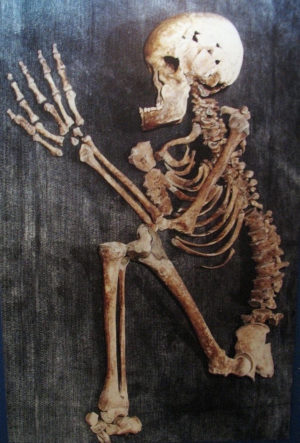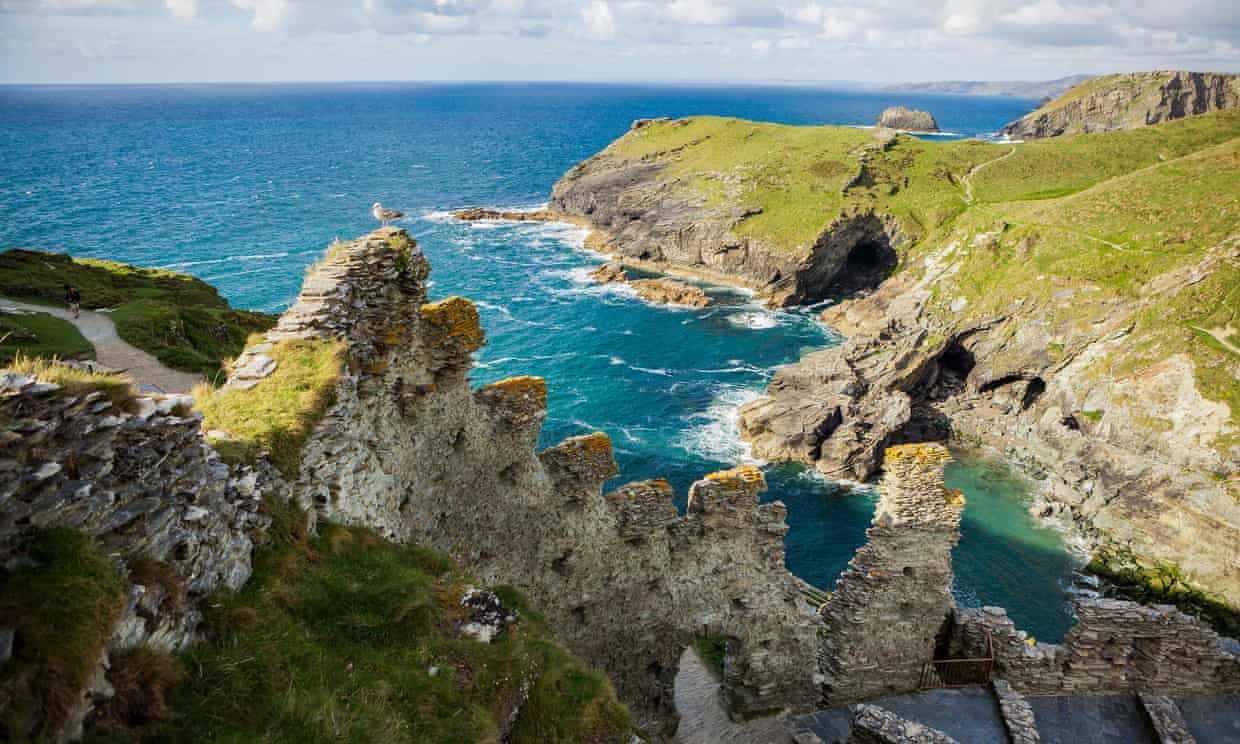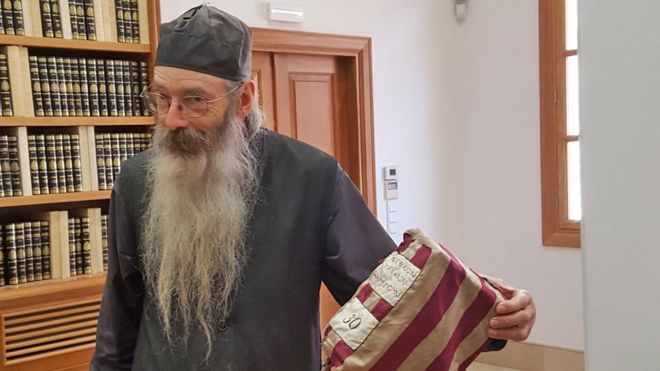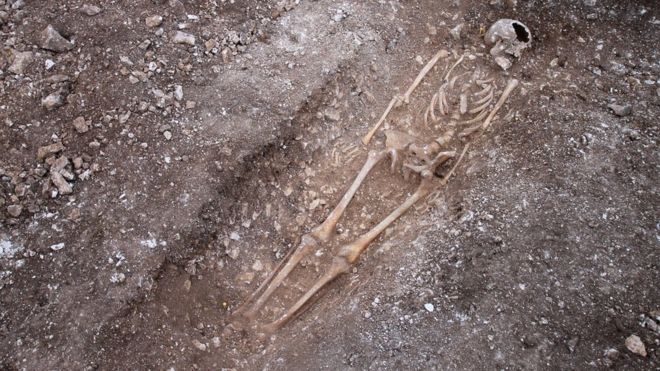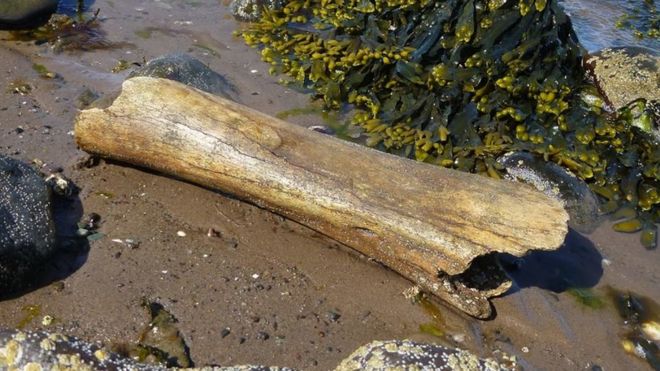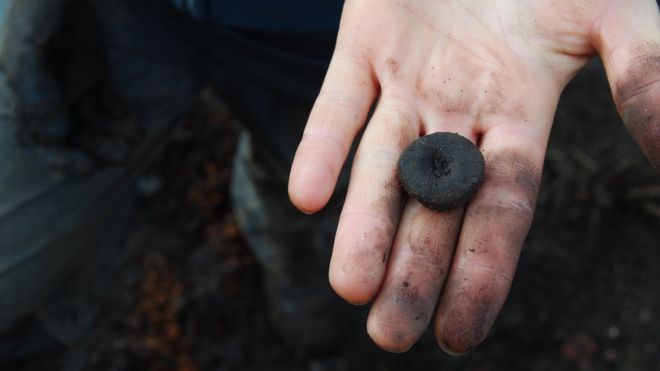Wednesday, June 20, 2018
New technique provides accurate dating of ancient skeletons
EUROPEAN SOCIETY OF HUMAN GENETICS—Milan, Italy: Interest in the origins of human populations and their migration routes has increased greatly in recent years. A critical aspect of tracing migration events is dating them. However, the radiocarbon techniques*, that are commonly used to date and analyze DNA from ancient skeletons can be inaccurate and not always possible to apply. Inspired by the Geographic Population Structure model that can track mutations in DNA that are associated with geography, researchers have developed a new analytic method, the Time Population Structure (TPS), that uses mutations to predict time in order to date the ancient DNA.
Dr Umberto Esposito, a postdoctoral researcher in the laboratory of Dr Eran Elhaik, Department of Animal and Plant Sciences at the University of Sheffield, Sheffield, UK, will tell the annual conference of the European Society of Human Genetics today (Monday) that TPS can calculate the mixtures of DNA deriving from different time periods to estimate its definitive age. “This introduces a completely new approach to dating. At this point, in its embryonic state, TPS has already shown that its results are very similar to those obtained with traditional radiocarbon dating.
Read the rest of this article...
Enigmatic Stone Balls from 5,000 Years Ago Continue to Baffle Archaeologists
The 3D models of the carved balls of stone, including the spiral-carved Towie ball (center), are now posted online. Credit: National Museums Scotland
Some of the most enigmatic human-made objects from Europe's late Stone Age — intricately carved balls of stone, each about the size of a baseball — continue to baffle archaeologists more than 200 years after they were first discovered.
More than 500 of the enigmatic objects have now been found, most of them in northeast Scotland, but also in the Orkney Islands, England, Ireland and one in Norway.
Archaeologists still don't know the original purpose or meaning of the Neolithic stone balls, which are recognized as some of the finest examples of Neolithic art found anywhere in the world. But now, they've created virtual 3D models of the gorgeous balls, primarily to share with the public. In addition, the models have revealed some new details, including once-hidden patterns in the carvings on the balls.
Read the rest of this article...
Archaeologists in Cambridgeshire find graves of two men with legs chopped off
‘Somebody really, really didn’t like these guys,’ says Jonathan House, archaeologist with the Mola Headland Infrastructure team.
Photograph: Highways England, courtesy of Mola Headland Infrastructure
Exclusive: men believed to be from late Roman or early Saxon period were found in pit being used as rubbish dump
The graves of two men whose legs were chopped off at the knees and placed carefully by their shoulders before burial have been discovered by archaeologists working on a huge linear site in advance of roadworks in Cambridgeshire.
The best scenario the archaeologists can hope for is that the unfortunate men were dead when their legs were mutilated. It also appears their skulls were smashed in, although that could be later damage.
“Was it to keep them in their graves and stop them from running away?” said Kasia Gdaniec, the senior archaeologist with Cambridge county council. “Or had they tried to run away and was this a punishment – and a warning to everyone else not even to think of it?”
Read the rest of this article...
How to decorate like a Viking
Grand Designs, Viking edition. A new report recreates some of the colours used by Vikings to decorate their houses, including ochre and charcoal pigments. (Photo: Sagnlandet Lejre)
To begin with you will need a handy Viking paint chart. Luckily, archaeologists in Denmark have just made one.
Green is the colour of hope, white symbolises surrender or innocence, and black binds the living to the dead.
Colour has always carried meaning for people, including the Vikings, for whom it symbolised power and wealth.
But what colours did the Vikings use?
Archaeologists and chemists have now studied colour use in the Viking Age based on the chemical analyses of pigments from a number of objects and a review of existing information on the topic.
These colours are now available to all in the form of a colour palette: A Viking paint chart.
Read the rest of this article...
DNA study reveals fate of Irish women taken by Vikings as slaves to Iceland
The Sea Stallion from Glendalough, a reconstructed Viking ship [Credit: Eric Luke]
The mapping of DNA from some of the settlers who colonised Iceland more than 1,000 years ago offers an insight into the fate of thousands of slaves – mostly women – who were taken by Norse Vikings from Ireland and Scotland before they put down roots on the North Atlantic island.
Anthropologist Sunna Ebenesersdóttir, of the University of Iceland and the company deCODE Genetics in Reykjavik, analysed the genomes of 25 ancient Icelanders whose skeletal remains were found in burial sites across the island.
Sequencing using samples from teeth revealed the settlers had a roughly even split of Norse (from what are today Norway and Sweden) and Gaelic ancestry. It is the first in-depth investigation of how a new population is formed through a genetic process known as “admixture”.
When the researchers compared the ancient genomes to those of modern people in Iceland and other European countries, they found contemporary Icelanders, on average, draw about 70 per cent of their genes from Norse ancestry.
This suggests that in the 1,100 years between settlement and today, the population underwent a surprisingly quick genetic shift in favour of Norse genes, the researchers report in the journal Science.
Anger at bird hide damage to Neolithic burial site
The hide, which has toppled over, was constructed on an ancient burial cairn
PAUL CAMPBELL
A makeshift bird hide has been built on the site of a Neolithic burial cairn, damaging the 3,000-year-old archaeological site.
Made from the canopy for a pick-up truck and a wooden pallet, it was constructed on one of three ancient cairns at Carn Glas, near Inverness.
Police Scotland said it was aware of the structure at Essich.
Historic Environment Scotland (HES) said it was taking enforcement action to have the hide removed.
Turf and stones were moved at the cairn, one of three at the site which are of a design usually found further north in the Highlands and also in Orkney.
The hide, which has toppled over, had been fixed in place by heavy metal pins.
Read the rest of this article...
Monday, June 18, 2018
Inscribed seventh-century window ledge unearthed at Tintagel
The slate ledge was found during excavations of Tintagel Castle in Cornwall, a site associated with the stories of King Arthur. Photograph: Nigel Wallace-Iles/English Herit/PA
A seventh-century slate window ledge inscribed with an intriguing mix of Latin, Greek and Celtic words, names and symbols has been unearthed at in north Cornwall.
The discovery adds weight to the view that the rugged coastal site, which is most often , was home in the early middle ages to a sophisticated and multicultural port community.
Put together with other finds including Iberian goblets and bowls from what is now Turkey, the slate ledge suggests Tintagel may well have been an important royal base with trade links stretching from Europe’s Atlantic coast to the eastern Mediterranean.
Read the rest of this article...
Large-scale whaling in north Scandinavia may date back to 6th century
Top: a board-game piece made from whalebone at the end of the 6th century CE, found in Gnistahögen near Uppsala, Sweden (photograph by Bengt Backlund, Uppland County Museum). Bottom: the bone structure of the gaming piece compared with reference bone from minke whale (photograph by Rudolf Gustavsson, Societas Archaeologica Upsaliensis, SAU) [Credit: Bengt Backlund/Rudolf Gustavsson]
Museum collections in Sweden contain thousands of Iron Age board-game pieces. New studies of the raw material composing them show that most were made of whalebone from the mid-6th century CE. They were produced in large volumes and standardised forms. The researchers therefore believe that a regular supply of whalebone was needed. Since the producers would hardly have found the carcasses of beached whales a reliable source, the gaming pieces are interpreted as evidence for whaling.
Apart from an osteological survey, species origin has been determined for a small number of game pieces, using ZooMS (short for Zooarchaeology by Mass Spectrometer). The method shows that all the pieces analysed were derived from the North Atlantic right whale (Eubalaena glacialis), a massive whale weighing 50-80 tonnes. It got the name because it was the right whale to hunt: it swam slowly, close to shore, and contained so much blubber as to float after being killed.
Read the rest of this article...
Bedfordshire's first Roman town wall unearthed in Sandy
Items discovered by Les Capon and his team include the skeleton of a woman, a funeral pyre, Roman rubbish and a pottery kiln
Archaeologists excavating a former allotment site in a market town have made the "absolutely brilliant" find of a previously-unknown Roman wall.
The dig in Sandy, Bedfordshire, has uncovered about 200 items dating from the Iron Age in 500 BC to the Saxon period in 800 AD.
Among the finds is the remains of a Saxon house.
The site, in Stratford Road, is to be turned into a cemetery, car park and council depot.
Read the rest of this article...
Possible discovery of prehistoric settlement near Thurso
Archaeologists are to make further investigations of the structures found
ORKNEY RESEARCH CENTRE FOR ARCHAEOLOGY
A community archaeology event may have uncovered a previously unknown prehistoric settlement in the Highlands.
Led by a team of archaeologists, more than 40 people, including children, dug a series of trenches at Thusater Burn near Thurso.
A geophysical survey had suggested the remains of a building beneath the soil.
The dig revealed rubble, a hearth constructed from stone slabs, a hammer stone and other tools.
A "wonderfully preserved" pig's tooth was also found. Archaeologists said such a find was usually associated with high status sites.
Read the rest of this article...
Wednesday, June 13, 2018
Imperial Roman villa found near Milvian Bridge
Credit: ANSA
An Imperial Roman villa has been found along the banks of the Tiber near the Milvian Bridge, archaeologists said Tuesday.
Digs have uncovered a large floor area in 'opus sectile', decorated with "extraordinary" multicoloured marble floral motifs, they said.
The beauty of the floor has led experts to believe that the rest of the building was full of precious decorations.
The villa's setting so close to the river is unusual, archaeologists said.
Detection of invisible elements in ancient rock engravings
Detailed picture of a bovine animal after applying the methodology
[Credit: Aroa Gutiérrez Alonso]
Two researchers from Universidad Politécnica de Madrid (UPM) in collaboration with a researcher from Czech University of Life Sciences Prague (CULS) have developed a methodology to detect archaeological elements invisible to the naked eye.
Starting from photographs taken with common digital cameras and the range of the visible spectrum, a team of researchers from School of Land Surveying, Geodesy and Mapping Engineering at UPM and Faculty of Environmental Sciences from CULS suggest a new non-invasive methodology of archaeological documentation and analysis to show digital elements that are invisible to the naked eye. The method consists of applying techniques of both remote sensing and spectral treatment in order to uncover hidden elements and later carry out their morphometric analysis.
Mercedes Farjas, Aroa Gutiérrez and José Antonio Domínguez started by studying a limestone mold in the lab. The first goal was to assess the influence of the angle of the light of the photographs.
Later, after studying the effect of diverse filters on the mold, the researchers carried out combination tests of the filters in order to create a protocol of sequential application that allowed them to obtain conclusive results. As a result of these tests, they selected a set of filters and established an order of application.
MISE AU JOUR D’UNE VILLA DE L’ANTIQUITÉ
À Vire (Calvados), l’Inrap conduit depuis la fin du mois de février 2018 une fouille d’envergure, sur prescription de l’Etat (Drac Normandie). Cette opération s’inscrit dans le cadre de l’extension du Parc d’activités La Papillonnière menée par la communauté de communes Intercom de la Vire au Noireau.
Les recherches d’une équipe d’archéologues ont permis de mettre au jour les vestiges d’une villa gallo-romaine occupée du Ier au IIIe siècle de notre ère. Ils témoignent de la richesse de son propriétaire. À l’ouest de la villa, le site livre également les vestiges d’une occupation plus tardive, entre les VIIe et Xe siècles.
Read the rest of this article...
Hidden writing in ancient desert monastery manuscripts
Fr Justin is helping to share online the historic manuscripts in an ancient Sinai monastery
For a monk who lives in the Sinai desert in Egypt, in the world's oldest working monastery, Father Justin replies to emails very speedily.
It should come as no surprise: the Greek Orthodox monk is in charge of hauling the library at St Catherine's into the 21st Century.
This ancient collection of liturgical texts, including some of the earliest Christian writing and second in size only to the Vatican, is going to be made available online for scholars all over the world.
The manuscripts, kept in a newly-renovated building which was opened to the public in December 2017, are now the subject of hi-tech academic detective work.
East meeting West
A team of scientists and photographers working alongside Fr Justin has been using multi-spectral imaging to reveal passages hidden beneath the manuscripts' visible text.
These include early medical guides, obscure ancient languages, and illuminating biblical revisions.
Among the researchers is Michelle P Brown, professor emerita of medieval manuscript studies at the University of London.
Read the rest of this article...
Tuesday, June 12, 2018
Why the next big archaeological discovery may not come out of the ground
Keith Kintigh speaks at the Coalition for Archaeological Synthesis launch.
Photo courtesy of Keith Kintigh
Keith Kintigh has seen the future of archaeology — and it’s not what you might expect. His vision includes projects that examine multiple sites together, rather than separately, and a science that answers questions about our present, instead of focusing only on the past.
Kintigh, a professor in the School of Human Evolution and Social Change and the co-director of its Center for Archaeology and Society, studies ancient political organization in the Zuni Pueblo region of New Mexico.
But in recent years, he’s devoted his attention to collecting archaeological data from numerous sites and regions, exploring overarching trends, and making information accessible to other scientists so they can do the same.
This process is known as archaeological synthesis. It first gained Kintigh’s interest nearly 30 years ago, when he and other faculty from the school decided to compare the trajectories of the prehistoric societies each of them studied independently in order to explore the conditions that led to their resilience or collapse.
Read the rest of this article...
South Downs skeleton 'executed 1,000 years ago'
The well-preserved skeleton, thought to be from the 11th Century, was found during excavations in the South Downs
A man whose remains were unearthed by construction workers was executed about 1,000 years ago, archaeologists believe.
The well-preserved skeleton, thought to be from the 11th Century, was found during excavations in the South Downs.
It is thought the man, found in a grave on Truleigh Hill near Shoreham, West Sussex, was aged between 25 and 35.
Bone analysis put the date of his death between 1010 and 1023, while cuts to the neck pointed to a violent end.
The skeleton was found intact, but with no signs of a coffin, with only a few bones missing from his hands and feet in 2015.
Read the rest of this article...
3,000-year-old Bronze Age oak road to be preserved in Co Westmeath
Bronze Age track at Mayne Bog: when Westland Horticulture uncovered it in 2005 the National Monuments Service did not issue a preservation order or record it in the Register of Historic Monuments
Bronze Age track at Mayne Bog: when Westland HoA 3,000-year-old, oak road through Mayne bog, near Coole in Co Westmeath is to be protected following an agreement between peat extraction companies and conservationists.
Under the terms of the agreement approved by the High Court, Westland Horticulture Limited, Westmeath Peat Limited and Cavan Peat Limited have committed to cease milling peat near the bronze-age road and establish a buffer zone around it and associated subterranean structural supports.
The agreement also provides for the development of a “bund” to prevent operations elsewhere from dewatering the area around the oak road and structures.
The discovery of the bog road was made in 2005 and the National Monuments Service established it was a grander and far longer oak road than the previously discovered, Iron Age road at Corlea Bog in Co Longford.rticulture uncovered it in 2005 the National Monuments Service did not issue a preservation order or record it in the Register of Historic Monuments
Read the rest of this article...
When prehistoric man lived around Glasgow
The Cochno Stone at Faifley was excavated in 2015 and 2016 and then reburied to protect it from damage. PIC: John Devlin/TSPL.
Prehistoric man was likely to have lived in a number of settlements scattered around present-day Glasgow, research has found. Analysis of ancient rock art sites has identified a “ring” of probable settlements around the city with the creation of Glasgow likely to have destroyed further evidence of Neolithic life in the area.
People settled close to the River Clyde from at least 3,000BC given the area’s quality farmland and good access to waterways, experts believe. READ MORE: Archaeologists hit jackpot after sun reveals Neolithic markings The findings come as Scotland’s Rock Art Project works with communities across the country to record in detail some 2,000 ancient sites where mysterious cup and ring carvings can be found.
Read the rest of this article...
Oldest Bubonic Plague Genome Decoded
Double burial of the two plague victims in the Samara region, Russia
[Credit: V.V. Kondrashin and V.A. Tsybin; Spyrou et al.
Nature Communications, 2018]
The plague, caused by the bacterium Yersinia pestis, was the cause of some of the world's deadliest pandemics, including the Justinian Plague, the Black Death, and the major epidemics that swept through China in the late 1800s. The disease continues to affect populations around the world today. Despite its historical and modern significance, the origin and age of the disease are not well understood. In particular, exactly when and where Y. pestis acquired the virulence profile that allows it to colonize and transmit through the flea vector has been unclear.
Recent studies of ancient Y. pestis genomes identified its earliest known variants, dating to the Late Neolithic and Early Bronze Age, but these genomes did not show the genetic signatures thought to make the plague particularly efficient - namely, adaptation to survival in fleas, which act as the main vectors that transmit the disease to mammals. This study aimed to look at more Bronze Age Y. pestis genomes, in order to investigate when and where these important adaptations occurred.
Read the rest of this article...
Woolly mammoth bone discovered on shore near Stranraer
The discovery was made on the shore near Stranraer
SOLWAY FIRTH PARTNERSHIP
A bone believed to have come from a woolly mammoth has been discovered on the south of Scotland coastline.
The find was made near Stranraer by Nic Coombey, co-ordinator of the Solway Coastwise project.
He said he realised straight away that it was an "extraordinary thing" due to its size.
It has now been passed to National Museums Scotland to carry out tests in order to find out exactly how old the bone might be.
Read the rest of this article...
Prehistoric roundhouse excavated at Tore near Inverness
A stone bead or spindle whorl from the excavation
AOC ARCHAEOLOGY
The remains of an ancient roundhouse have been uncovered by archaeologists in the Highlands.
The prehistoric property was excavated ahead of the construction of a new business park at Mullan's Wood at Tore, near Inverness.
Archaeologists said the roundhouse may have been built in the Iron Age 2,000 years ago, or earlier.
The excavation area has been reinstated and the site will be protected during the future building work.
Environmental samples taken during the fieldwork has the potential to provide material for dating the site.
Read the rest of this article...
Tuesday, June 05, 2018
Viking houses from 1070 found in Cork dig at former Beamish & Crawford brewery
Excavations at a former brewery in Cork have uncovered the foundations of 19 wooden Viking age houses from the 11th and 12th centuries.
Some of the structures date back to 1070, making them 30 years older than any housing previously excavated in the city.
The dig at the former Beamish & Crawford factory also found three stone walls and a doorway from St Laurence’s Church, dating back to the 13th century.
Cork’s urban layout as a Viking city dates from around the same time that Waterford began developing as a Viking city, but archaeologists have yet to find any evidence on Leeside comparable to a trading post established near Waterford in the ninth century, archaeologists have found.
Read the rest of this article...
How Jesus Died: Rare Evidence of Roman Crucifixion Found
This cross was erected inside the Roman Colosseum as a monument to the suffering of early Christians in Rome. The Christian Bible describes the crucifixion of Jesus Christ as occurring in Jerusalem under Roman rule at the beginning of the Christian era.
Credit: Jared I. Lenz Photography/Getty
The body of a man buried in northern Italy 2,000 years ago shows signs that he died after being nailed to a wooden cross, the method used for the execution of Jesus described in the Christian Bible.
Although crucifixion was a common form of capital punishment for criminals and slaves in ancient Roman times, the new finding is only the second time that direct archaeological evidence of it has been found.
A new study of the skeletal remains of the man, found near Venice in 2007, reveals a lesion and unhealed fracture on one of the heel bones that suggests his feet had been nailed to a cross.
Read the rest of this article...
Roman Tomb Unearthed; to Everyone’s Surprise, It’s Intact
Some of the funerary wares found in a chamber tomb near Rome.CreditRomano D'Agostino, Special Superintendence for Rome
ROME — Sometimes the most extraordinary finds occur by sheer luck.
At least that was the case of a fourth century B.C. chamber tomb that came to light five weeks ago during the construction of an aqueduct in a Rome suburb, when an earthmover accidentally opened a hole in the side of the chamber.
“Had the machine dug just four inches to the left, we would have never found the tomb,” Francesco Prosperetti, Rome’s special superintendent with archaeological oversight, told reporters on Friday. The tomb contained the remains of four occupants — three men and a woman — and funerary wares.
Read the rest of this article...
Iceland’s founding fathers underwent a rapid, 1000-year genetic shift
Scientists analyzed the ancient genes of skeletons belonging to some of Iceland’s first settlers, like this one discovered in a grave near the island’s northern coast.
IVAR BRYNJOLFSSON/THE NATIONAL MUSEUM OF ICELAND
If modern Icelanders came face-to-face with their founding fathers, they’d be hard-pressed to see much family resemblance, according to a new study. That’s because today’s Icelanders have a much higher proportion of Scandinavian genes than their distant ancestors did, suggesting the islanders underwent a remarkably rapid genetic shift over the past thousand years.
Previous studies have hinted as much based on inferences from modern genotypes, notes Jonathan Pritchard, a population geneticist at Stanford University in Palo Alto, California, who wasn’t involved in the work. But the new findings offer a rare, direct glimpse of the founding of a new people. “I don’t think this has been shown before in any human population.”
Medieval histories suggest Iceland was first settled between 870 C.E. and 930 C.E. by seafaring Vikings and the people they enslaved, who possessed a mélange of genes from what is now Norway and the British Isles. For the next thousand years, the population of Iceland remained relatively small and isolated, hovering between about 10,000 and 50,000. Impeccable genealogical records and broad genetic sampling have made Icelanders—who now number 330,000—a model population for geneticists hoping to connect the dots between gene variants and traits.
Read the rest of this article...
The Genes From Iceland's First Settlers Reveal The Origin Of Their Population In Detail
Skeletal remains of an ancient pre-Christian (<1000 c.e.="" female="" font="" icelandic="" nbsp="">
[Credit: Ivar Brynjolfsson/The National Museum of Iceland]
This is one of the main conclusions of a study carried out by an international team of scientists which included members of the Spanish National Research Council (CSIC). For the first time, the researchers, whose results are published in the journal Science, analysed the ancient genomes of 25 individuals who lived in Iceland during the colonisation of the island.
With a population of 330,000, Iceland is a country with its own peculiarities. Genes are no exception: isolation and inbreeding throughout its history make this northern Atlantic island a paradise for genetic studies.
Read the rest of this article...
Archaeologists uncover 'treasure trove' of artefacts at Pictish fort
A pin decorated with a bramble is among items discovered at the Pictish fort
UNIVERSITY OF ABERDEEN
A "treasure trove" of Pictish artefacts has been discovered in the remains of an ancient fort on the Moray coast.
The building near Burghhead is believed to have been destroyed by fire in the 10th century as the Vikings invaded.
It spelled the end of Pictish life in the area but the blaze preserved material that would normally have rotted away hundreds of years ago.
As well as a complex layer of oak planks in a wall, archaeologists have uncovered jewellery and animal bones.
Read the rest of this article...
Take your pick: Is this Britain's oldest tin mining tool?
New research suggests Cornwall can lay claim to having Britain's oldest tin mining tool.
A pick made from a deer antler found near Truro in the 1800s has been on show at the Royal Cornwall Museum for decades.
Part of the prehistoric tool has now been radiocarbon dated, revealing that it is about 3,500 years old.
Simon Timberlake, a freelance archaeologist from Cambridge, said it's still in a remarkable condition
Read the rest of this article...
Archäologen erforschen Antike mit Laserscanning
Mit "Airborne Laserscanning" (ALS) in die Antike: Dank dieses Verfahrens zur Erfassung und Kartierung lassen sich Stätten des Altertums zerstörungsfrei untersuchen. In einem Artikel für das Fachblatt PNAS berichten Archäologe Prof. Dr. Achim Lichtenberger und Kollegen über ALS in Jordanien.
Read the rest of this article...
Subscribe to:
Comments (Atom)
